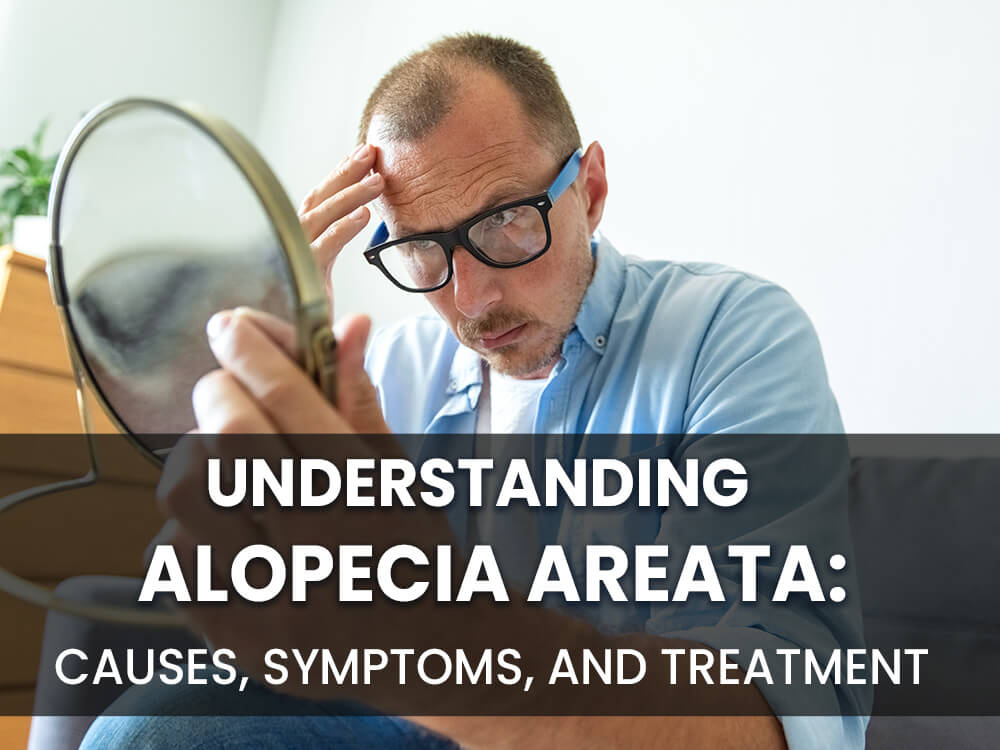
Alopecia Areata is a hair loss condition that affects both men and women. It is characterized by the sudden loss of hair in patches, which can eventually lead to complete baldness. While the exact cause of Alopecia Areata is still unknown, there are several factors that are believed to contribute to its development. This article aims to provide a comprehensive understanding of Alopecia Areata, including its causes, symptoms, and available treatment options.
What is Alopecia Areata?
Alopecia Areata is an autoimmune condition that affects the hair follicles, causing them to become inflamed and eventually resulting in hair loss. It is different from other types of hair loss, such as male pattern baldness, as it does not follow a predictable pattern. Instead, Alopecia Areata causes hair loss in random patches on the scalp, face, and other areas of the body.
Alopecia Areata is a complex condition that involves a malfunction of the immune system. Normally, the immune system protects the body from foreign invaders, such as bacteria and viruses. However, in the case of Alopecia Areata, the immune system mistakenly attacks the hair follicles, treating them as if they were foreign substances. This attack leads to inflammation and subsequent hair loss.
Defining Alopecia Areata
Alopecia Areata is characterized by the presence of circular or oval-shaped bald patches on the scalp. These patches are usually smooth and devoid of hair, and they can range in size from small coin-sized spots to larger areas of hair loss. The affected areas may be itchy or painful, and some individuals may experience a tingling or burning sensation in the affected areas.
It is important to note that Alopecia Areata can vary in severity from person to person. Some individuals may only experience a few small patches of hair loss, while others may have extensive hair loss that affects the entire scalp or body. The course of the condition is unpredictable, with periods of hair regrowth followed by periods of hair loss.
Prevalence and Demographics
Alopecia Areata can affect people of all ages, races, and genders. It is estimated that it affects approximately 2% of the population worldwide. The condition often first appears during childhood or adolescence, but it can also develop in adulthood. While the exact cause of Alopecia Areata is unknown, research suggests that both genetic and environmental factors play a role in its development.
Studies have shown that individuals with a family history of the condition are more likely to develop Alopecia Areata. Additionally, certain autoimmune disorders, such as rheumatoid arthritis and thyroid disease, have been associated with an increased risk of developing the condition.
Although Alopecia Areata is not contagious and does not pose any significant health risks, it can have a profound effect on an individual’s self-esteem and quality of life. The sudden and unpredictable nature of hair loss can be emotionally distressing, leading to feelings of embarrassment, self-consciousness, and social isolation. It is important for individuals with Alopecia Areata to seek support from healthcare professionals, support groups, and loved ones to cope with the emotional impact of the condition.
The Causes of Alopecia Areata
While the exact cause of Alopecia Areata is still unknown, researchers believe that it is a complex condition influenced by a combination of genetic, environmental, and autoimmune factors.
Alopecia Areata is a condition that affects the hair follicles, resulting in hair loss. It can occur in both men and women of all ages. The condition is characterized by the sudden onset of patchy hair loss, which can progress to complete baldness in some cases.
Genetic Factors
There is evidence to suggest that individuals with a family history of Alopecia Areata are more likely to develop the condition themselves. Certain genes may predispose individuals to an increased risk of developing autoimmune disorders, including Alopecia Areata.
Researchers have identified specific gene variants that are associated with an increased susceptibility to Alopecia Areata. These gene variants are involved in regulating the immune system and may contribute to the abnormal immune response seen in individuals with the condition.
It is important to note that having these gene variants does not guarantee that an individual will develop Alopecia Areata. Other factors, such as environmental triggers, play a role in the development and progression of the condition.
Environmental Triggers
Environmental factors, such as stress, trauma, and viral infections, may trigger or worsen the onset of Alopecia Areata. Psychological stress, in particular, has been linked to the development and exacerbation of the condition.
Stressful life events, such as the loss of a loved one, divorce, or job loss, can activate the body’s stress response system. This can lead to the release of stress hormones, which may disrupt the normal functioning of the immune system and contribute to the development of autoimmune disorders, including Alopecia Areata.
In addition to stress, trauma to the hair follicles, such as from a tight hairstyle or excessive pulling, can trigger the onset of Alopecia Areata. This is known as traction alopecia and is more commonly seen in individuals who frequently wear tight hairstyles, such as braids or ponytails.
Viral infections, particularly those caused by certain viruses, have also been implicated as potential triggers for Alopecia Areata. It is believed that these viruses may stimulate an abnormal immune response, leading to hair loss.
Autoimmune Connections
Alopecia Areata is primarily considered an autoimmune disorder, in which the body’s immune system mistakenly attacks the hair follicles. It is believed that this immune response disrupts the normal hair growth cycle, leading to hair loss.
The exact mechanisms underlying the autoimmune response in Alopecia Areata are still not fully understood. However, it is thought that certain immune cells, known as T cells, play a key role in the destruction of hair follicles.
In individuals with Alopecia Areata, T cells infiltrate the hair follicles and release inflammatory molecules that cause damage to the follicles. This leads to the interruption of the hair growth cycle and the subsequent shedding of hair.
It is important to note that Alopecia Areata is not contagious and does not result from poor hygiene or dietary factors. It is a complex condition with multiple contributing factors, and further research is needed to fully understand its causes and develop effective treatments.
Recognizing the Symptoms of Alopecia Areata
Identifying the early signs and symptoms of Alopecia Areata is crucial for early intervention and treatment. The condition typically presents with distinct characteristics.
Initial Signs
One of the first signs of Alopecia Areata is the appearance of small, smooth bald patches on the scalp or other areas of the body. These patches may be accompanied by mild itching or burning sensation, but they are usually painless. Hair loss may occur suddenly or gradually, and it may progress over time.
Progression of the Condition
In some cases, Alopecia Areata may progress to affect larger areas of the scalp or body, leading to more extensive hair loss. It is important to monitor the condition closely and seek medical attention if there are any significant changes in the pattern or extent of hair loss.
Associated Health Conditions
While Alopecia Areata primarily affects the hair follicles, it is often associated with other autoimmune disorders, such as thyroid disease, vitiligo, and rheumatoid arthritis. Individuals with Alopecia Areata should be mindful of their overall health and discuss any potential underlying conditions with their healthcare provider.
Diagnosis of Alopecia Areata
Diagnosing Alopecia Areata typically involves a thorough medical history and physical examination, as well as specific laboratory tests to rule out other potential causes of hair loss.
Medical History and Physical Examination
Your healthcare provider will ask about your symptoms, family history, and any recent changes or events that may have triggered the hair loss. They will also conduct a physical examination of your scalp and affected areas to evaluate the pattern and severity of hair loss.
Laboratory Tests
In some cases, your healthcare provider may order specific laboratory tests, such as blood tests or a scalp biopsy, to confirm the diagnosis of Alopecia Areata and rule out other underlying conditions.
Treatment Options for Alopecia Areata
While there is no known cure for Alopecia Areata, there are various treatment options available to manage the condition and promote hair regrowth.
Medications and Topical Treatments
Topical corticosteroids, such as creams or ointments, are commonly prescribed to reduce inflammation and promote hair regrowth. Other medications, such as minoxidil, may also be recommended to stimulate hair follicles and encourage new hair growth.
Therapies and Procedures
In some cases, therapies such as light therapy, corticosteroid injections, or immunotherapy may be recommended to treat Alopecia Areata. These treatments aim to modulate the immune response and stimulate hair regrowth.
Lifestyle Changes and Home Remedies
While not proven to be effective for everyone, some individuals with Alopecia Areata have reported positive results with certain lifestyle changes and home remedies. These may include stress management techniques, scalp massage, and the use of essential oils or natural hair care products.
Understanding Alopecia Areata requires knowledge of its causes, symptoms, and available treatment options. While the exact cause of the condition remains unknown, it is believed to be influenced by genetic, environmental, and autoimmune factors. Recognizing the early signs of hair loss and seeking timely diagnosis and treatment is key to managing the condition effectively. While there is no cure for Alopecia Areata, various treatment options are available to promote hair regrowth and alleviate symptoms. It is important for individuals with this condition to work closely with healthcare professionals to develop a personalized treatment plan and address any associated health conditions.



